compute OBB
so either use PCA or this
to obtain 3D OBB. The code in the link must be ported to 3D but the principle is the same. Here my more advanced 3D OBB approximation using recursive search on cube_map (the code and approach in here is inferior to it).
initial guess
so OBB will give you oriented bounding box. Its biggest side will be parallel to rotation axis of your cylinder. So lets start with cylinder outscribing this OBB. So the central axis will be center of the OBB and parallel to its biggest side. (if you do not have biggest side then you need to check all 3 combinations). The diameter will be the bigger of the remaining sides.
fit cylinder
Now just try "all" combinations of offset and radius (may be also height) enclosing all your points near initial guess and remember the best one (according to your wanted specs). You can use any optimization method for this but my favorite is this:
The validity of the result depends on the fitting process. But do not get too wild with the nested fitting as the complexity goes wild too.
[Edit1] 3D OBB in C++
I was curious and got some time today so I encoded 3D OBB similar to the 2D example linked above. Looks like its working. This is preview:

I used 2 clusters to verify the orientation... Here the code (in form of simple C++ class):
//---------------------------------------------------------------------------
class OBB3D
{
public:
double p0[3],u[3],v[3],w[3]; // origin,3 axises sorted by size asc
double V,l[3]; // volume, and { |u|,|v|,|w| }
double p[8*3]; // corners
OBB3D() {}
OBB3D(OBB3D& a) { *this=a; }
~OBB3D() {}
OBB3D* operator = (const OBB3D *a) { *this=*a; return this; }
//OBB3D* operator = (const OBB3D &a) { ...copy... return this; }
void compute(double *pnt,int num) // pnt[num] holds num/3 points
{
OBB3D o; // temp OBB values
int i,j;
double a,_a,a0,a1,da,ca,sa; int ea; // search angles
double b,_b,b0,b1,db,cb,sb; int eb;
double c,_c,c0,c1,dc,cc,sc; int ec;
double u0[3],v0[3],pmin[3],pmax[3],q,*qq;
const double deg=M_PI/180.0;
p0[0]=0.0; u[0]=1.0; v[0]=0.0; w[0]=0.0; l[0]=0.0; V=-1.0;
p0[1]=0.0; u[1]=0.0; v[1]=1.0; w[1]=0.0; l[1]=0.0;
p0[2]=0.0; u[2]=0.0; v[2]=0.0; w[2]=1.0; l[2]=0.0;
if (num<3) { V=0.0; return; }
a0=0; a1=360.0*deg; da=10.0*deg; _a=a0;
b0=0; b1= 90.0*deg; db=10.0*deg; _b=b0;
c0=0; c1= 90.0*deg; dc=10.0*deg; _c=c0;
// recursively increase precision
for (j=0;j<5;j++)
{
// try all 3D directions with some step da,db
for (ea=1,a=a0;ea;a+=da){ if (a>=a1) { a=a1; ea=0; } ca=cos(a); sa=sin(a);
for (eb=1,b=b0;eb;b+=db){ if (b>=b1) { b=b1; eb=0; } cb=cos(b); sb=sin(b);
// spherical to cartesian direction
o.w[0]=cb*ca;
o.w[1]=cb*sa;
o.w[2]=sb;
// init u,v from cross product
vector_ld(u0,1.0,0.0,0.0);
if (fabs(vector_mul(u0,o.w))>0.75) // |dot(u,w)>0.75| measn near (anti)parallel
vector_ld(u0,0.0,1.0,0.0);
vector_mul(v0,o.w,u0); // v0 = cross(w,u0)
vector_mul(u0,v0,o.w); // u0 = cross(v0,w)
vector_one(u0,u0); // u0/=|u0|
vector_one(v0,v0); // v0/=|v0|
// try all rotations within u0,v0 plane
for (ec=1,c=c0;ec;c+=dc){ if (c>=c1) { c=c1; ec=0; } cc=cos(c); sc=sin(c);
for (i=0;i<3;i++)
{
o.u[i]=(u0[i]*cc)-(v0[i]*sc);
o.v[i]=(u0[i]*sc)+(v0[i]*cc);
}
// now u,v,w holds potential obb axises socompute min,max
pmin[0]=pmax[0]=vector_mul(pnt,o.u); // dot(pnt,u);
pmin[1]=pmax[1]=vector_mul(pnt,o.v); // dot(pnt,v);
pmin[2]=pmax[2]=vector_mul(pnt,o.w); // dot(pnt,w);
for (i=0;i<num;i+=3)
{
q=vector_mul(pnt+i,o.u); if (pmin[0]>q) pmin[0]=q; if (pmax[0]<q) pmax[0]=q;
q=vector_mul(pnt+i,o.v); if (pmin[1]>q) pmin[1]=q; if (pmax[1]<q) pmax[1]=q;
q=vector_mul(pnt+i,o.w); if (pmin[2]>q) pmin[2]=q; if (pmax[2]<q) pmax[2]=q;
}
// compute V,l from min,max
for (o.V=1.0,i=0;i<3;i++) { o.l[i]=pmax[i]-pmin[i]; o.V*=o.l[i]; }
// remember best solution u,v,w,V,l and compute p0
if ((V<0.0)||(V>o.V))
{
*this=o; _a=a; _b=b; _c=c;
for (i=0;i<3;i++) p0[i]=(pmin[0]*u[i])+(pmin[1]*v[i])+(pmin[2]*w[i]);
}
}
}}
a0=(_a-0.5*da); a1=a0+da; da*=0.1;
b0=(_b-0.5*db); b1=b0+db; db*=0.1;
c0=(_c-0.5*dc); c1=c0+dc; dc*=0.1;
}
// sort axises
{ i=0; qq=u; } // w is max
if (l[1]>l[i]){ i=1; qq=v; }
if (l[2]>l[i]){ i=2; qq=w; }
for (j=0;j<3;j++) { q=w[j]; w[j]=qq[j]; qq[j]=q; } q=l[2]; l[2]=l[i]; l[i]=q;
{ i=0; qq=u; } // v is 2nd max
if (l[1]>l[i]){ i=1; qq=v; }
for (j=0;j<3;j++) { q=v[j]; v[j]=qq[j]; qq[j]=q; } q=l[1]; l[1]=l[i]; l[i]=q;
// compute corners from p0,u,v,w,l
for (i=0;i<3;i++)
{
j=i;
p[j]=p0[i] ; j+=3;
p[j]=p0[i]+(l[0]*u[i]) ; j+=3;
p[j]=p0[i]+(l[0]*u[i])+(l[1]*v[i]) ; j+=3;
p[j]=p0[i] +(l[1]*v[i]) ; j+=3;
p[j]=p0[i] +(l[2]*w[i]); j+=3;
p[j]=p0[i]+(l[0]*u[i]) +(l[2]*w[i]); j+=3;
p[j]=p0[i]+(l[0]*u[i])+(l[1]*v[i])+(l[2]*w[i]); j+=3;
p[j]=p0[i] +(l[1]*v[i])+(l[2]*w[i]); j+=3;
}
}
void gl_draw()
{
glBegin(GL_LINES);
glVertex3dv(p+ 0); glVertex3dv(p+ 3);
glVertex3dv(p+ 3); glVertex3dv(p+ 6);
glVertex3dv(p+ 6); glVertex3dv(p+ 9);
glVertex3dv(p+ 9); glVertex3dv(p+ 0);
glVertex3dv(p+12); glVertex3dv(p+15);
glVertex3dv(p+15); glVertex3dv(p+18);
glVertex3dv(p+18); glVertex3dv(p+21);
glVertex3dv(p+21); glVertex3dv(p+12);
glVertex3dv(p+ 0); glVertex3dv(p+12);
glVertex3dv(p+ 3); glVertex3dv(p+15);
glVertex3dv(p+ 6); glVertex3dv(p+18);
glVertex3dv(p+ 9); glVertex3dv(p+21);
glEnd();
}
} obb;
//---------------------------------------------------------------------------
You just call compute with point cloud data where num is 3x number of points. The result is stored as unit basis vectors u,v,w and origin p0 along with sizes l[] per each axis or as 8 corner points of OBB p
The stuff works simply by trying "all" spherical positions with some step for the w axis and then try all u,v polar positions perpendicular to each and w remembering the minimal volume OBB. Then recursively search only positions near found best solution with smaller step to improve accuracy.
I think this should provide fine start point. If you implement the minimal circle instead of u,v rotation (loop for (ec=1,c=c0;ec;c+=dc)) then you might obtain your cylinder directly from this search.
The code is not optimized yet (some parts like w axis check) can be moved to lower layer of nested for loop. But I wanted to keep this simple and understandable as much as I could instead.
[Edit2] 3D OBC in C++
I managed to modify my 3D OBB by replacing U,V search with minimal enclosing circle (hope I implemented it right but it looks like it...) that find the minimal enclosing 2D circle of all the points projected on UV plane which makes it an Oriented Bounding Cylinder parallel to W. I used the first approach from pdf from your link (using bisector). Here the result:

In blue is the 3D OBB and in brown/orange-ish is the found 3D OBC. Here the code:
class OBC3D // 3D Oriented Bounding Cylinder
{
public:
double p0[3],u[3],v[3],w[3]; // basecenter,3 axises
double V,r,h; // volume, radius height
double p1[3]; // other base center
OBC3D() {}
OBC3D(OBC3D& a) { *this=a; }
~OBC3D() {}
OBC3D* operator = (const OBC3D *a) { *this=*a; return this; }
//OBC3D* operator = (const OBC3D &a) { ...copy... return this; }
void compute(double *pnt,int num) // pnt[num] holds num/3 points
{
OBC3D o; // temp OBB values
int i,j,k,kk,n;
double a,_a,a0,a1,da,ca,sa; int ea; // search angles
double b,_b,b0,b1,db,cb,sb; int eb;
double pmin[3],pmax[3],q,qq,*pnt2,p[3],c0,c1,u0,v0,du,dv,dr;
const double deg=M_PI/180.0;
p0[0]=0.0; u[0]=1.0; v[0]=0.0; w[0]=0.0; V=-1.0;
p0[1]=0.0; u[1]=0.0; v[1]=1.0; w[1]=0.0; r=0.0;
p0[2]=0.0; u[2]=0.0; v[2]=0.0; w[2]=1.0; h=0.0;
if (num<3) { V=0.0; return; }
// prepare buffer for projected points
pnt2=new double[num];
a0=0; a1=360.0*deg; da=10.0*deg; _a=a0;
b0=0; b1= 90.0*deg; db=10.0*deg; _b=b0;
// recursively increase precision
for (k=0;k<5;k++)
{
// try all 3D directions with some step da,db
for (ea=1,a=a0;ea;a+=da){ if (a>=a1) { a=a1; ea=0; } ca=cos(a); sa=sin(a);
for (eb=1,b=b0;eb;b+=db){ if (b>=b1) { b=b1; eb=0; } cb=cos(b); sb=sin(b);
// spherical to cartesian direction
o.w[0]=cb*ca;
o.w[1]=cb*sa;
o.w[2]=sb;
// init u,v from cross product
vector_ld(o.u,1.0,0.0,0.0);
if (fabs(vector_mul(o.u,o.w))>0.75) // |dot(u,w)>0.75| measn near (anti)parallel
vector_ld(o.u,0.0,1.0,0.0);
vector_mul(o.v,o.w,o.u); // v0 = cross(w,u0)
vector_mul(o.u,o.v,o.w); // u0 = cross(v0,w)
vector_one(o.u,o.u); // u0/=|u0|
vector_one(o.v,o.v); // v0/=|v0|
// now u,v,w holds potential obb axises so compute min,max and convert to local coordinates
pmin[0]=pmax[0]=vector_mul(pnt,o.u); // dot(pnt,u);
pmin[1]=pmax[1]=vector_mul(pnt,o.v); // dot(pnt,v);
pmin[2]=pmax[2]=vector_mul(pnt,o.w); // dot(pnt,w);
for (i=0;i<num;i+=3)
{
q=vector_mul(pnt+i,o.u); if (pmin[0]>q) pmin[0]=q; if (pmax[0]<q) pmax[0]=q; pnt2[i+0]=q;
q=vector_mul(pnt+i,o.v); if (pmin[1]>q) pmin[1]=q; if (pmax[1]<q) pmax[1]=q; pnt2[i+1]=q;
q=vector_mul(pnt+i,o.w); if (pmin[2]>q) pmin[2]=q; if (pmax[2]<q) pmax[2]=q; pnt2[i+2]=q;
}
// [compute min enclosing circle]
n=0;
// center (u0,v0) = avg( pnt2 )
for (u0=0.0,v0=0.0,i=0;i<num;i+=3)
{
u0+=pnt2[i+0];
v0+=pnt2[i+1];
} q=3.0/double(num); u0*=q; v0*=q;
// r = max(|pnt2 - (u0,v0)|)
for (o.r=0.0,i=0;i<num;i+=3)
{
c0=pnt2[i+0]-u0;
c1=pnt2[i+1]-v0;
q=(c0*c0)+(c1*c1);
if (o.r<q) o.r=q;
} o.r=sqrt(o.r);
for (kk=0;kk<4;kk++)
{
// update edgepoints count n
qq=o.r*o.r;
for (i=n;i<num;i+=3)
{
c0=pnt2[i+0]-u0;
c1=pnt2[i+1]-v0;
q=fabs((c0*c0)+(c1*c1)-qq);
if (q<1e-10)
{
pnt2[n+0]=pnt2[i+0];
pnt2[n+1]=pnt2[i+1];
pnt2[n+2]=pnt2[i+2]; n+=3;
}
}
// compute bisector (du,dv)
for (du=0.0,dv=0.0,i=0;i<n;i+=3)
{
du+=pnt2[i+0]-u0;
dv+=pnt2[i+1]-v0;
} q=1.0/sqrt((du*du)+(dv*dv)); du*=q; dv*=q;
// try to move center towards edge points as much as possible
for (dr=0.1*o.r,j=0;j<5;)
{
u0+=dr*du;
v0+=dr*dv;
// q = max(|pnt2 - (u0,v0)|)
for (qq=0.0,i=0;i<num;i+=3)
{
c0=pnt2[i+0]-u0;
c1=pnt2[i+1]-v0;
q=(c0*c0)+(c1*c1);
if (qq<q) qq=q;
} qq=sqrt(qq);
// recursively increase precision
if (qq>o.r)
{
u0-=dr*du;
v0-=dr*dv;
dr*=0.1;
j++;
}
else o.r=qq;
}
}
// compute h,V
o.h=pmax[2]-pmin[2];
o.V=M_PI*o.r*o.r*o.h;
// remember best solution u,v,w,V,l and compute p0
if ((V<0.0)||(V>o.V))
{
*this=o; _a=a; _b=b;
for (i=0;i<3;i++) p0[i]=(u0*u[i])+(v0*v[i])+(pmin[2]*w[i]);
}
}}
a0=(_a-0.5*da); a1=a0+da; da*=0.1;
b0=(_b-0.5*db); b1=b0+db; db*=0.1;
}
// compute corners from p0,u,v,w,l
for (i=0;i<3;i++) p1[i]=p0[i]+(h*w[i]);
delete[] pnt2;
}
void gl_draw()
{
int i,j,n=36;
double a,da=2.0*M_PI/double(n),p[3],uu,vv;
glBegin(GL_LINES);
glVertex3dv(p0); glVertex3dv(p1);
glEnd();
glBegin(GL_LINE_LOOP);
for (a=0.0,i=0;i<n;i++,a+=da)
{
uu=r*cos(a);
vv=r*sin(a);
for (j=0;j<3;j++) p[j]=p0[j]+(u[j]*uu)+(v[j]*vv);
glVertex3dv(p);
}
glEnd();
glBegin(GL_LINE_LOOP);
for (a=0.0,i=0;i<n;i++,a+=da)
{
uu=r*cos(a);
vv=r*sin(a);
for (j=0;j<3;j++) p[j]=p1[j]+(u[j]*uu)+(v[j]*vv);
glVertex3dv(p);
}
glEnd();
}
};
//---------------------------------------------------------------------------
Usage is the same ... I tested with this:
OBB3D obb;
OBC3D obc;
void compute()
{
int i,n=500;
// random pnt cloud
Randomize();
RandSeed=98123456789;
pnt.allocate(3*n); pnt.num=0;
// random U,V,W basis vectors
double u[3],v[3],w[3],x,y,z,a;
for (i=0;i<3;i++) w[i]=Random()-0.5; // random direction
vector_one(w,w); // w/=|w|
vector_ld(u,1.0,0.0,0.0);
if (fabs(vector_mul(u,w))>0.75) // |dot(u,w)>0.75| measn near (anti)parallel
vector_ld(u,0.0,1.0,0.0);
vector_mul(v,w,u); // v = cross(w,u)
vector_mul(u,v,w); // u = cross(v,w)
vector_one(u,u); // u/=|u|
vector_one(v,v); // v/=|v|
// random cylinder point cloud
for (i=0;i<n;i++)
{
a=2.0*M_PI*Random();
x= 0.5+(0.75*(Random()-0.5))*cos(a);
y=-0.3+(0.50*(Random()-0.5))*sin(a);
z= 0.4+(0.90*(Random()-0.5));
pnt.add((x*u[0])+(y*v[0])+(z*w[0]));
pnt.add((x*u[1])+(y*v[1])+(z*w[1]));
pnt.add((x*u[2])+(y*v[2])+(z*w[2]));
}
obb.compute(pnt.dat,pnt.num);
obc.compute(pnt.dat,pnt.num);
}
Where List<double> pnt is my dynamic array template double pnt[]. Which is not important in here.
Beware that if you chose too big initial step (da,db) for the W direction search you might miss the correct solution by trapping itself inside local minimum.






 .
.


